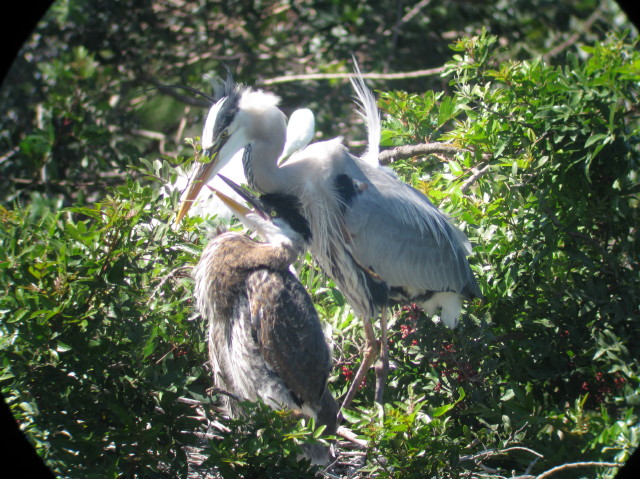March 2, 2010 at 9:46 am
It is March 2nd, and although I received 3 inches of snow 2 nights ago at my home, it was wet and heavy snow and had melted by noon. The wind is blowing, but it is relatively warm air, sending me a hint of spring with every gust.
Birds are starting to move. Recent observations of FOY (that’s “first of year” in case you’re not a birder) osprey and turkey vultures remind me that great blue herons will return to Maine within a few weeks’ time. If my memory is correct, the first great blue heron that was reported on the Maine Birds List in 2009 was on March 12th in Brunswick. Two weeks later on March 27th, one was reported on Mount Desert Island. During aerial surveys for nesting bald eagles on March 26th, we flew over 8 great blue heron colony sites to find 2 of them already partially occupied.
These dates are fast approaching, so keep your eyes open for early arrivals.
The majority of Maine’s colonies don’t appear to become “active” until the middle or end of April, which coincides with the usual ice-out timing of most lakes in the state.
[caption id="attachment_237" align="alignleft" width="300" caption="Floridian great blue heron nestling and adult. Photo by Doug Albert."] [/caption]
Meanwhile, in Florida where some herons remain year-round, the breeding season has been in full swing for some time now. Doug Albert shared this photo of a nestling great blue heron taken on February 25th in Sanibel. The nestling appears to be at least 4 weeks old, which means the adult laid the egg on or around the first of the year! This is even early for a Florida-resident bird, but it reminds us that timing of breeding depends very much on location, location, location!
In Maine, we won’t see nestlings of this age for another 3 months. And at that time, our HERON volunteers will be out there with their spotting scopes and binoculars, stealthily sneaking through the woods and wetlands. And with pencil and paper in hand, they’ll be ready to document it!
[/caption]
Meanwhile, in Florida where some herons remain year-round, the breeding season has been in full swing for some time now. Doug Albert shared this photo of a nestling great blue heron taken on February 25th in Sanibel. The nestling appears to be at least 4 weeks old, which means the adult laid the egg on or around the first of the year! This is even early for a Florida-resident bird, but it reminds us that timing of breeding depends very much on location, location, location!
In Maine, we won’t see nestlings of this age for another 3 months. And at that time, our HERON volunteers will be out there with their spotting scopes and binoculars, stealthily sneaking through the woods and wetlands. And with pencil and paper in hand, they’ll be ready to document it!
 [/caption]
Meanwhile, in Florida where some herons remain year-round, the breeding season has been in full swing for some time now. Doug Albert shared this photo of a nestling great blue heron taken on February 25th in Sanibel. The nestling appears to be at least 4 weeks old, which means the adult laid the egg on or around the first of the year! This is even early for a Florida-resident bird, but it reminds us that timing of breeding depends very much on location, location, location!
In Maine, we won’t see nestlings of this age for another 3 months. And at that time, our HERON volunteers will be out there with their spotting scopes and binoculars, stealthily sneaking through the woods and wetlands. And with pencil and paper in hand, they’ll be ready to document it!
[/caption]
Meanwhile, in Florida where some herons remain year-round, the breeding season has been in full swing for some time now. Doug Albert shared this photo of a nestling great blue heron taken on February 25th in Sanibel. The nestling appears to be at least 4 weeks old, which means the adult laid the egg on or around the first of the year! This is even early for a Florida-resident bird, but it reminds us that timing of breeding depends very much on location, location, location!
In Maine, we won’t see nestlings of this age for another 3 months. And at that time, our HERON volunteers will be out there with their spotting scopes and binoculars, stealthily sneaking through the woods and wetlands. And with pencil and paper in hand, they’ll be ready to document it!Categories